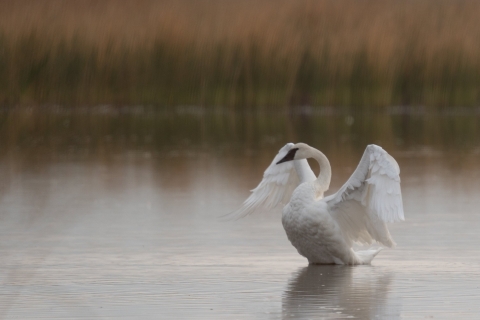About Us
Bear Lake National Wildlife Refuge was established in 1968 to protect and manage habitat for waterfowl and other migratory birds. Located seven miles south of Montpelier, the refuge encompasses 18,000 acres of cattail marsh, open water, and flooded meadows that are managed by the U.S. Fish and Wildlife Service. The refuge provides valuable habitat for waterfowl and colonial nesting water birds. Portions of the refuge include scattered grasslands and brush-covered mountain slopes.
Our Mission
The mission of the National Wildlife Refuge System is to administer a national network of lands and waters for the conservation, management and, where appropriate, restoration of the fish, wildlife and plant resources and their habitats within the United States for the benefit of present and future generations of Americans.
Every national wildlife refuge national wildlife refuge
A national wildlife refuge is typically a contiguous area of land and water managed by the U.S. Fish and Wildlife Service for the conservation and, where appropriate, restoration of fish, wildlife and plant resources and their habitats for the benefit of present and future generations of Americans.
Learn more about national wildlife refuge was created for a special purpose. Some were created to protect migratory birds, others to protect threatened or endangered species or unique habitats, while others fulfill another special purpose. All activities allowed on refuges must be evaluated to make sure each activity will not conflict with the reason the refuge was founded.
The purpose of the Bear Lake National Wildlife Refuge is to serve as an inviolate sanctuary for migratory birds and for the development, advancement, management, conservation, and protection of fish and wildlife resources.
Our History
Bear Lake National Wildlife Refuge, which was established in 1968, is located within Bear Lake County, near the community of Montpelier, Idaho. The 18,169-acre Refuge lies in Bear Lake Valley at an elevation of 5,925 feet and occupies a portion of the historic Dingle Swamp along the Bear River and north of Bear Lake.
Other Facilities in this Complex
Oxford Slough Waterfowl Production Area which is managed by the staff at the Bear Lake National Wildlife Refuge, is situated in the Cache Valley and is the drainage for Oxford and Deep Creeks as well as other smaller streams that cascade down from the surrounding mountains. The Oxford Slough WPA was established in 1985 to preserve an important wetland for waterfowl production. WPA lands are purchased with funds generated by the sale of Federal Duck Stamps, and managed by the Service to establish and protect waterfowl breeding and nesting habitats. Oxford Slough WPA is one of nearly 7,000 WPAs nationwide, and the only WPA in Region 1. The 1,878-acre WPA is located 10 miles north of Preston, Idaho, abutting the small town of Oxford, where it provides valuable foraging habitat for species such as cranes, geese, Franklin’s gulls, and white-faced ibis, and nesting habitat not only for waterfowl, but white-faced ibis, Franklin’s gulls, and other waterbirds. Oxford Slough WPA has been designated as a Globally Important Bird Area by the National Audubon Society based on its contributions to colonial nesting waterbird habitat.
The Refuge also manages the 1,015-acre Thomas Fork Unit, located 20 miles to the east of the Refuge on the Idaho/Wyoming border. The Unit's eastern boundary is the Wyoming State line. The Unit provides breeding habitat for greater sandhill cranes and high quality stream habitat for Bonneville cutthroat trout.
The Refuge is also the home for Idaho portion of the Bear River Watershed Conservation Area. This program works to protect farm and ranch land that has high wildlife conservation through the voluntary purchase of conservation easements on private land in the Bear River watershed.


